Research Report: Motivation Strategies at Iceland Supermarket
VerifiedAdded on 2019/12/28
|23
|5223
|439
Report
AI Summary
This research report delves into the crucial topic of employee motivation within the context of Iceland Supermarket. It begins with an introduction outlining the background, rationale, aims, objectives, and research questions. The report then reviews relevant literature, exploring concepts and theories of motivation, including Maslow's need hierarchy and Herzberg's two-factor theory, alongside their impact on employee performance and retention. The methodology section details the research philosophy, approach, data collection and analysis methods, sampling techniques, ethical considerations, and limitations. The core of the report presents data analysis, likely from questionnaires, to assess the motivational strategies employed by Iceland Supermarket. Finally, the conclusion and recommendations summarize the findings, offering insights into effective motivational techniques and their application within the organization. The report emphasizes the importance of both financial and non-financial tools of motivation, such as staff discounts, training, and work-life balance, in fostering employee satisfaction, performance, and retention.
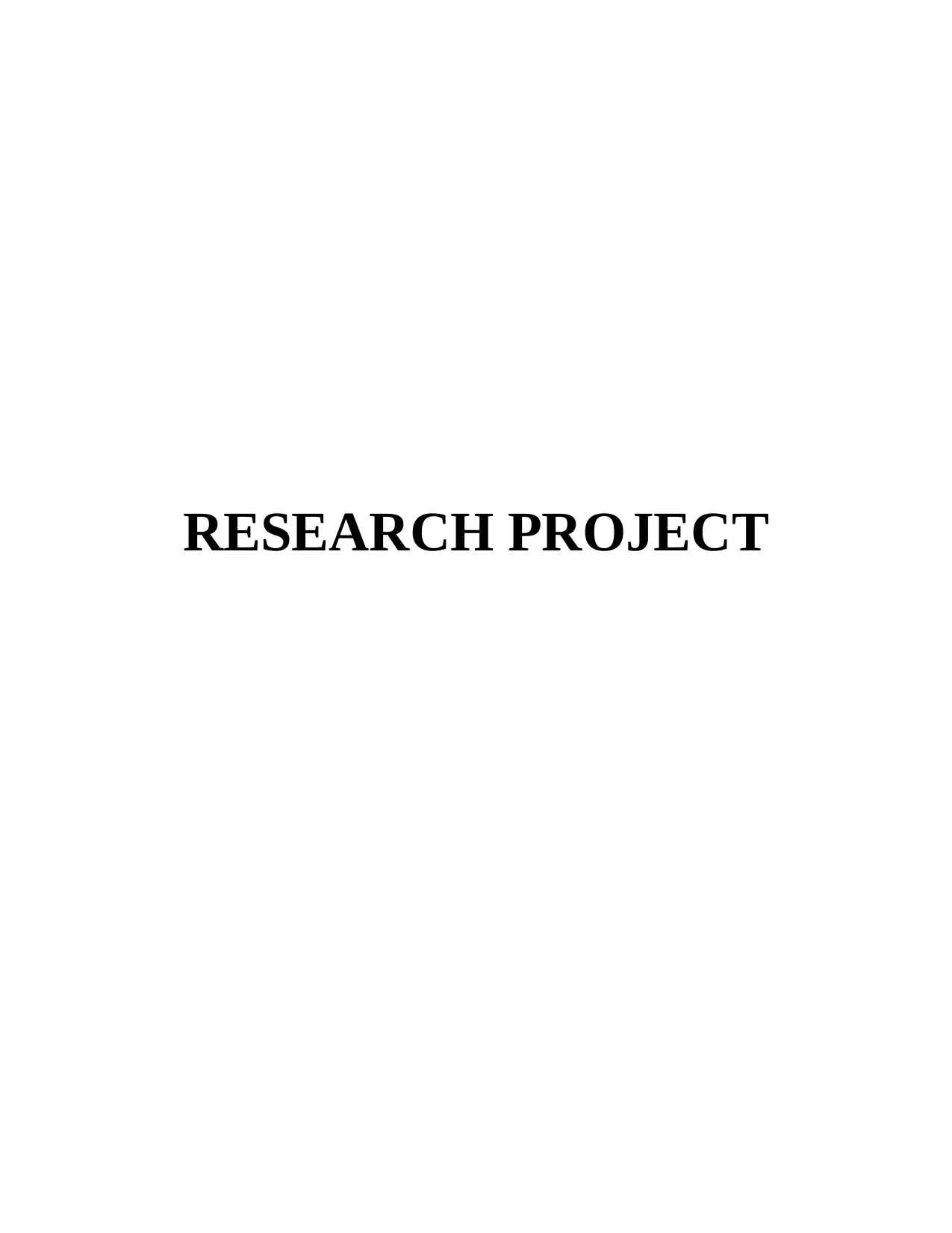
RESEARCH PROJECT
Paraphrase This Document
Need a fresh take? Get an instant paraphrase of this document with our AI Paraphraser
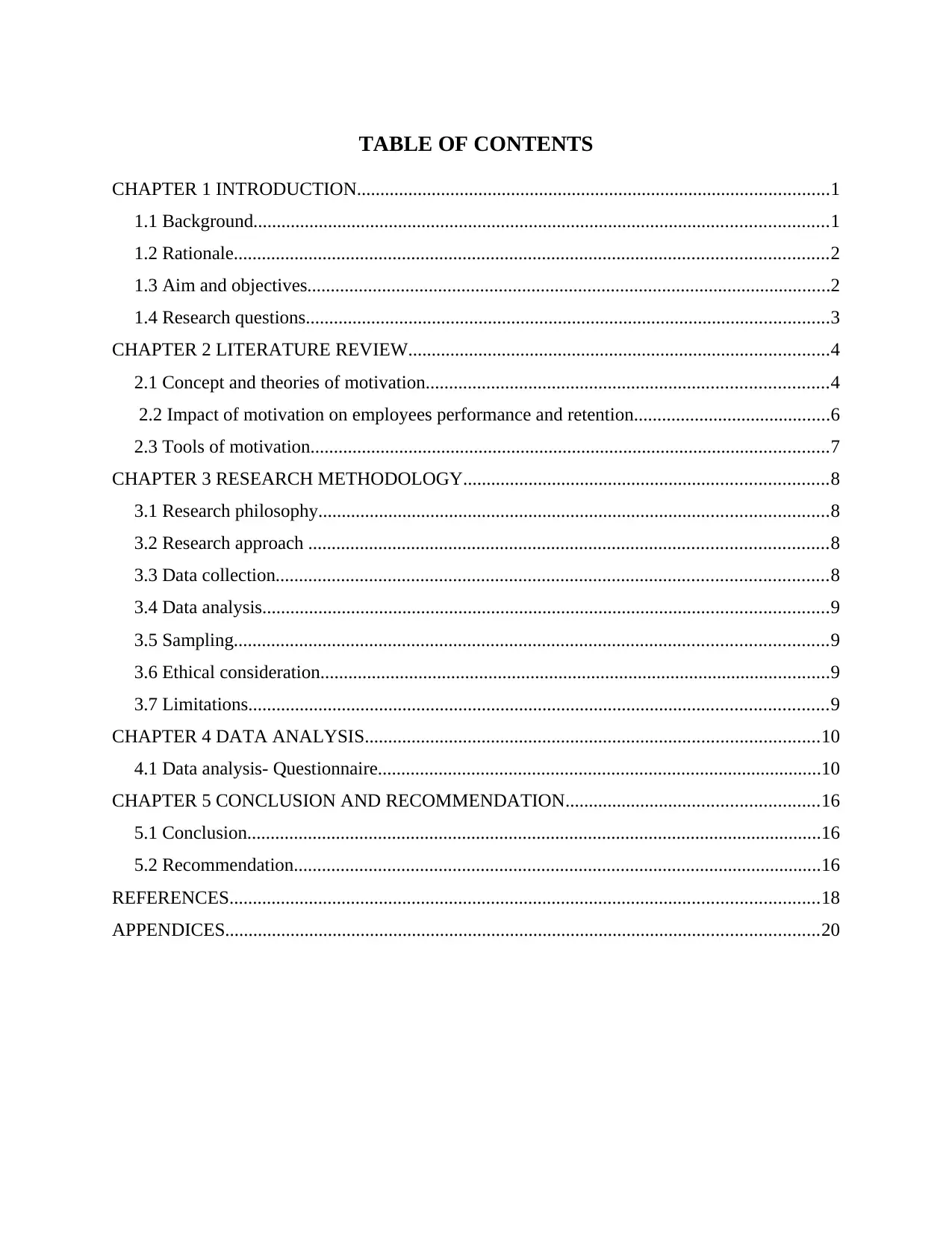
TABLE OF CONTENTS
CHAPTER 1 INTRODUCTION.....................................................................................................1
1.1 Background...........................................................................................................................1
1.2 Rationale...............................................................................................................................2
1.3 Aim and objectives................................................................................................................2
1.4 Research questions................................................................................................................3
CHAPTER 2 LITERATURE REVIEW..........................................................................................4
2.1 Concept and theories of motivation......................................................................................4
2.2 Impact of motivation on employees performance and retention..........................................6
2.3 Tools of motivation...............................................................................................................7
CHAPTER 3 RESEARCH METHODOLOGY..............................................................................8
3.1 Research philosophy.............................................................................................................8
3.2 Research approach ...............................................................................................................8
3.3 Data collection......................................................................................................................8
3.4 Data analysis.........................................................................................................................9
3.5 Sampling...............................................................................................................................9
3.6 Ethical consideration.............................................................................................................9
3.7 Limitations............................................................................................................................9
CHAPTER 4 DATA ANALYSIS.................................................................................................10
4.1 Data analysis- Questionnaire...............................................................................................10
CHAPTER 5 CONCLUSION AND RECOMMENDATION......................................................16
5.1 Conclusion...........................................................................................................................16
5.2 Recommendation.................................................................................................................16
REFERENCES..............................................................................................................................18
APPENDICES...............................................................................................................................20
CHAPTER 1 INTRODUCTION.....................................................................................................1
1.1 Background...........................................................................................................................1
1.2 Rationale...............................................................................................................................2
1.3 Aim and objectives................................................................................................................2
1.4 Research questions................................................................................................................3
CHAPTER 2 LITERATURE REVIEW..........................................................................................4
2.1 Concept and theories of motivation......................................................................................4
2.2 Impact of motivation on employees performance and retention..........................................6
2.3 Tools of motivation...............................................................................................................7
CHAPTER 3 RESEARCH METHODOLOGY..............................................................................8
3.1 Research philosophy.............................................................................................................8
3.2 Research approach ...............................................................................................................8
3.3 Data collection......................................................................................................................8
3.4 Data analysis.........................................................................................................................9
3.5 Sampling...............................................................................................................................9
3.6 Ethical consideration.............................................................................................................9
3.7 Limitations............................................................................................................................9
CHAPTER 4 DATA ANALYSIS.................................................................................................10
4.1 Data analysis- Questionnaire...............................................................................................10
CHAPTER 5 CONCLUSION AND RECOMMENDATION......................................................16
5.1 Conclusion...........................................................................................................................16
5.2 Recommendation.................................................................................................................16
REFERENCES..............................................................................................................................18
APPENDICES...............................................................................................................................20
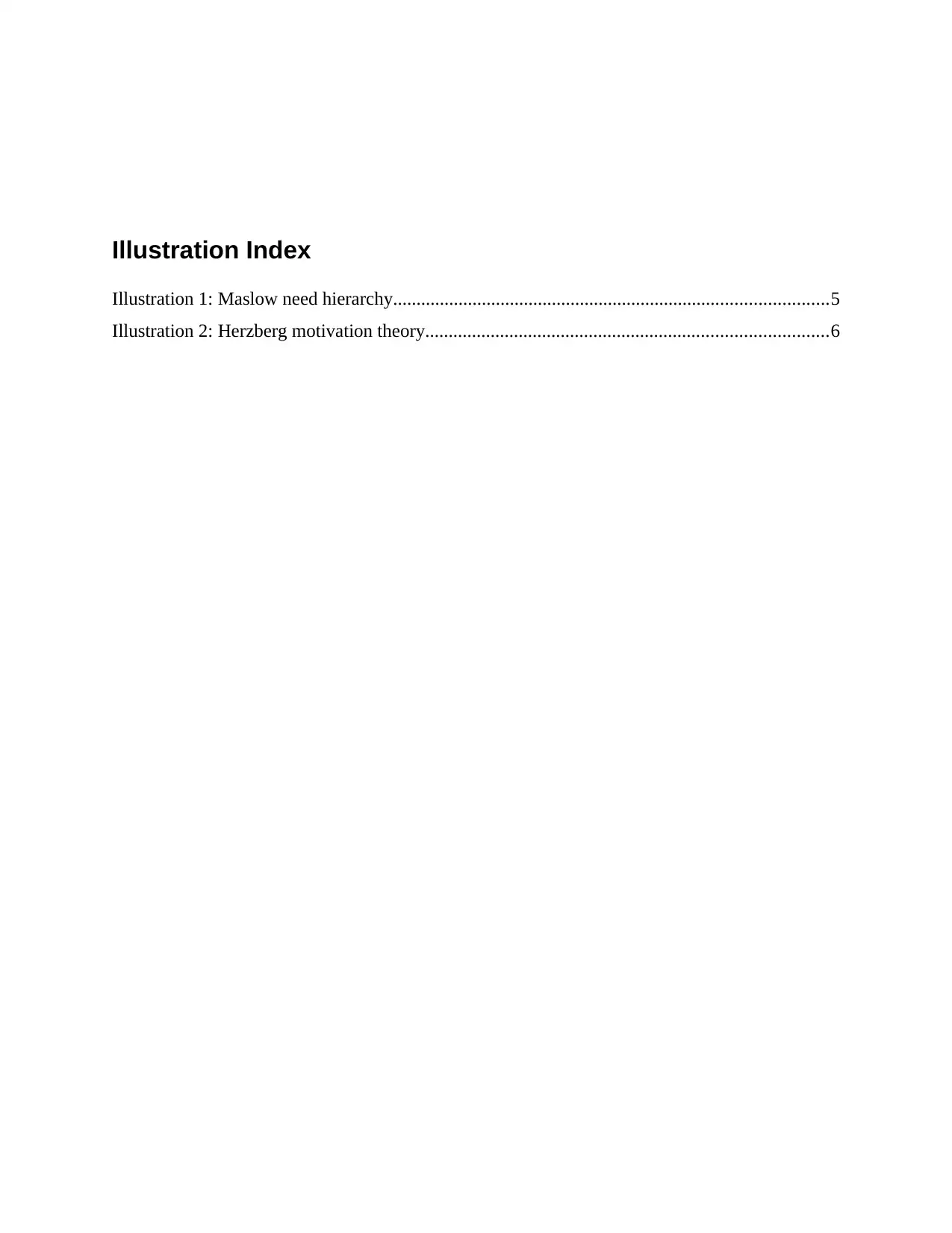
Illustration Index
Illustration 1: Maslow need hierarchy.............................................................................................5
Illustration 2: Herzberg motivation theory......................................................................................6
Illustration 1: Maslow need hierarchy.............................................................................................5
Illustration 2: Herzberg motivation theory......................................................................................6
⊘ This is a preview!⊘
Do you want full access?
Subscribe today to unlock all pages.

Trusted by 1+ million students worldwide
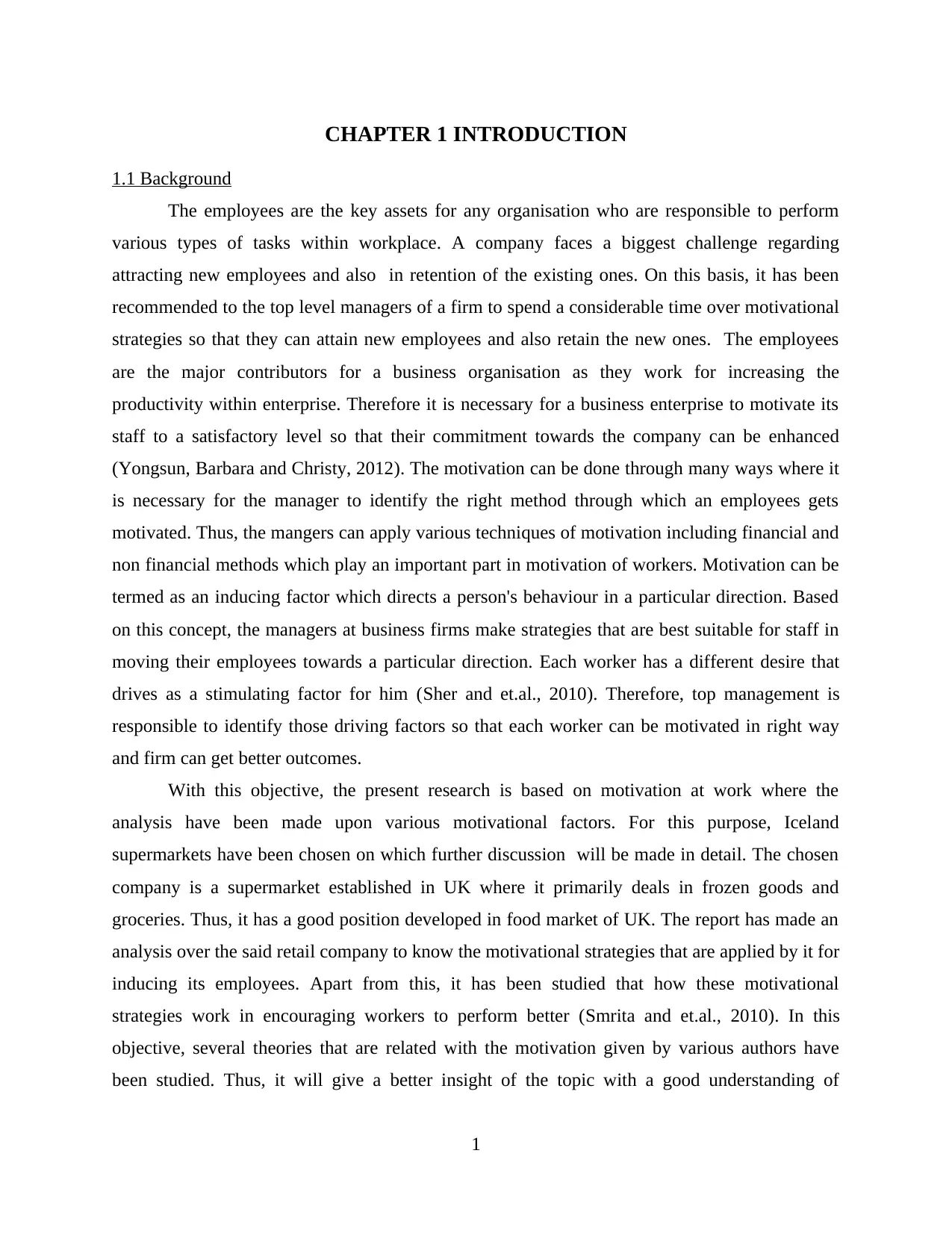
CHAPTER 1 INTRODUCTION
1.1 Background
The employees are the key assets for any organisation who are responsible to perform
various types of tasks within workplace. A company faces a biggest challenge regarding
attracting new employees and also in retention of the existing ones. On this basis, it has been
recommended to the top level managers of a firm to spend a considerable time over motivational
strategies so that they can attain new employees and also retain the new ones. The employees
are the major contributors for a business organisation as they work for increasing the
productivity within enterprise. Therefore it is necessary for a business enterprise to motivate its
staff to a satisfactory level so that their commitment towards the company can be enhanced
(Yongsun, Barbara and Christy, 2012). The motivation can be done through many ways where it
is necessary for the manager to identify the right method through which an employees gets
motivated. Thus, the mangers can apply various techniques of motivation including financial and
non financial methods which play an important part in motivation of workers. Motivation can be
termed as an inducing factor which directs a person's behaviour in a particular direction. Based
on this concept, the managers at business firms make strategies that are best suitable for staff in
moving their employees towards a particular direction. Each worker has a different desire that
drives as a stimulating factor for him (Sher and et.al., 2010). Therefore, top management is
responsible to identify those driving factors so that each worker can be motivated in right way
and firm can get better outcomes.
With this objective, the present research is based on motivation at work where the
analysis have been made upon various motivational factors. For this purpose, Iceland
supermarkets have been chosen on which further discussion will be made in detail. The chosen
company is a supermarket established in UK where it primarily deals in frozen goods and
groceries. Thus, it has a good position developed in food market of UK. The report has made an
analysis over the said retail company to know the motivational strategies that are applied by it for
inducing its employees. Apart from this, it has been studied that how these motivational
strategies work in encouraging workers to perform better (Smrita and et.al., 2010). In this
objective, several theories that are related with the motivation given by various authors have
been studied. Thus, it will give a better insight of the topic with a good understanding of
1
1.1 Background
The employees are the key assets for any organisation who are responsible to perform
various types of tasks within workplace. A company faces a biggest challenge regarding
attracting new employees and also in retention of the existing ones. On this basis, it has been
recommended to the top level managers of a firm to spend a considerable time over motivational
strategies so that they can attain new employees and also retain the new ones. The employees
are the major contributors for a business organisation as they work for increasing the
productivity within enterprise. Therefore it is necessary for a business enterprise to motivate its
staff to a satisfactory level so that their commitment towards the company can be enhanced
(Yongsun, Barbara and Christy, 2012). The motivation can be done through many ways where it
is necessary for the manager to identify the right method through which an employees gets
motivated. Thus, the mangers can apply various techniques of motivation including financial and
non financial methods which play an important part in motivation of workers. Motivation can be
termed as an inducing factor which directs a person's behaviour in a particular direction. Based
on this concept, the managers at business firms make strategies that are best suitable for staff in
moving their employees towards a particular direction. Each worker has a different desire that
drives as a stimulating factor for him (Sher and et.al., 2010). Therefore, top management is
responsible to identify those driving factors so that each worker can be motivated in right way
and firm can get better outcomes.
With this objective, the present research is based on motivation at work where the
analysis have been made upon various motivational factors. For this purpose, Iceland
supermarkets have been chosen on which further discussion will be made in detail. The chosen
company is a supermarket established in UK where it primarily deals in frozen goods and
groceries. Thus, it has a good position developed in food market of UK. The report has made an
analysis over the said retail company to know the motivational strategies that are applied by it for
inducing its employees. Apart from this, it has been studied that how these motivational
strategies work in encouraging workers to perform better (Smrita and et.al., 2010). In this
objective, several theories that are related with the motivation given by various authors have
been studied. Thus, it will give a better insight of the topic with a good understanding of
1
Paraphrase This Document
Need a fresh take? Get an instant paraphrase of this document with our AI Paraphraser
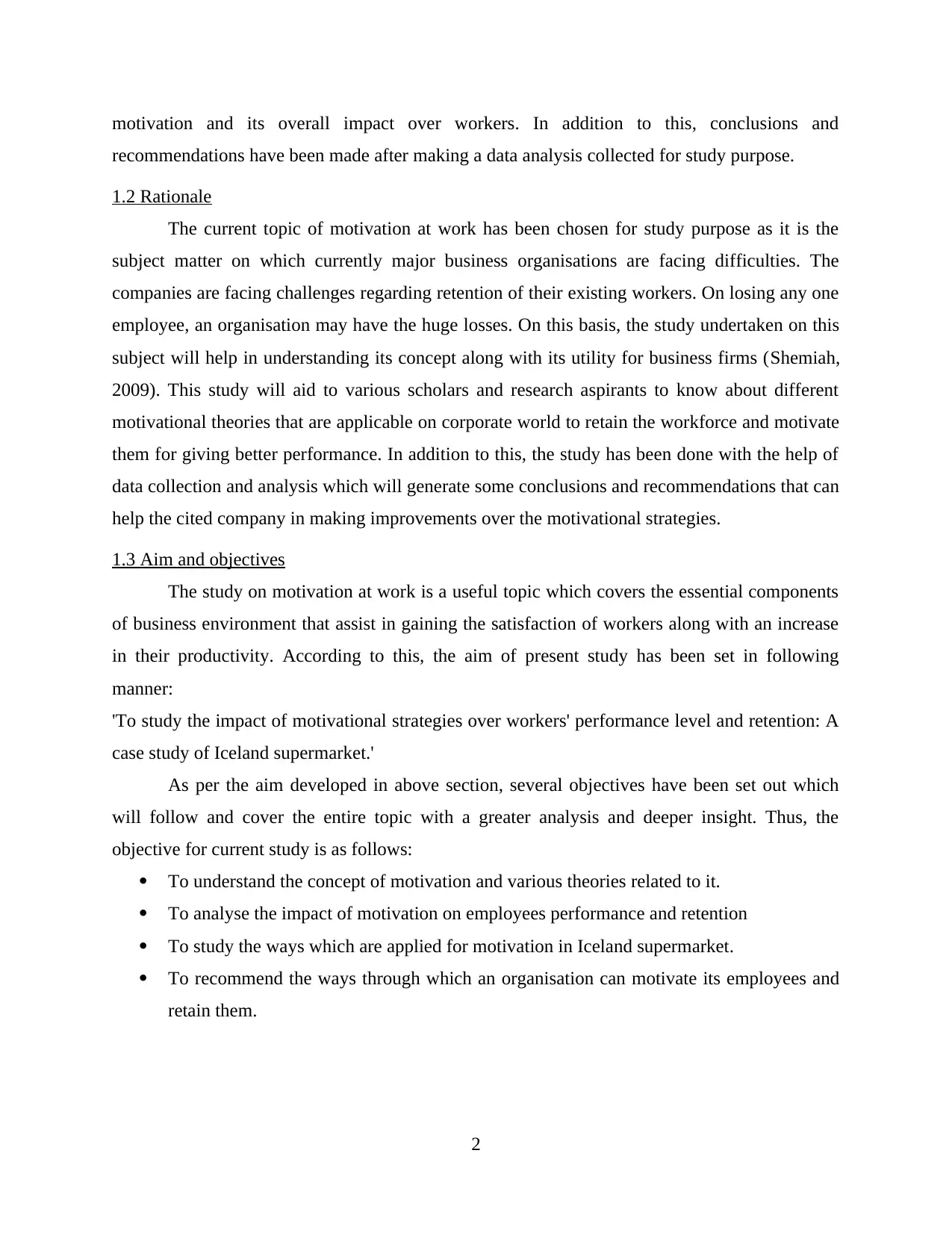
motivation and its overall impact over workers. In addition to this, conclusions and
recommendations have been made after making a data analysis collected for study purpose.
1.2 Rationale
The current topic of motivation at work has been chosen for study purpose as it is the
subject matter on which currently major business organisations are facing difficulties. The
companies are facing challenges regarding retention of their existing workers. On losing any one
employee, an organisation may have the huge losses. On this basis, the study undertaken on this
subject will help in understanding its concept along with its utility for business firms (Shemiah,
2009). This study will aid to various scholars and research aspirants to know about different
motivational theories that are applicable on corporate world to retain the workforce and motivate
them for giving better performance. In addition to this, the study has been done with the help of
data collection and analysis which will generate some conclusions and recommendations that can
help the cited company in making improvements over the motivational strategies.
1.3 Aim and objectives
The study on motivation at work is a useful topic which covers the essential components
of business environment that assist in gaining the satisfaction of workers along with an increase
in their productivity. According to this, the aim of present study has been set in following
manner:
'To study the impact of motivational strategies over workers' performance level and retention: A
case study of Iceland supermarket.'
As per the aim developed in above section, several objectives have been set out which
will follow and cover the entire topic with a greater analysis and deeper insight. Thus, the
objective for current study is as follows:
To understand the concept of motivation and various theories related to it.
To analyse the impact of motivation on employees performance and retention
To study the ways which are applied for motivation in Iceland supermarket.
To recommend the ways through which an organisation can motivate its employees and
retain them.
2
recommendations have been made after making a data analysis collected for study purpose.
1.2 Rationale
The current topic of motivation at work has been chosen for study purpose as it is the
subject matter on which currently major business organisations are facing difficulties. The
companies are facing challenges regarding retention of their existing workers. On losing any one
employee, an organisation may have the huge losses. On this basis, the study undertaken on this
subject will help in understanding its concept along with its utility for business firms (Shemiah,
2009). This study will aid to various scholars and research aspirants to know about different
motivational theories that are applicable on corporate world to retain the workforce and motivate
them for giving better performance. In addition to this, the study has been done with the help of
data collection and analysis which will generate some conclusions and recommendations that can
help the cited company in making improvements over the motivational strategies.
1.3 Aim and objectives
The study on motivation at work is a useful topic which covers the essential components
of business environment that assist in gaining the satisfaction of workers along with an increase
in their productivity. According to this, the aim of present study has been set in following
manner:
'To study the impact of motivational strategies over workers' performance level and retention: A
case study of Iceland supermarket.'
As per the aim developed in above section, several objectives have been set out which
will follow and cover the entire topic with a greater analysis and deeper insight. Thus, the
objective for current study is as follows:
To understand the concept of motivation and various theories related to it.
To analyse the impact of motivation on employees performance and retention
To study the ways which are applied for motivation in Iceland supermarket.
To recommend the ways through which an organisation can motivate its employees and
retain them.
2
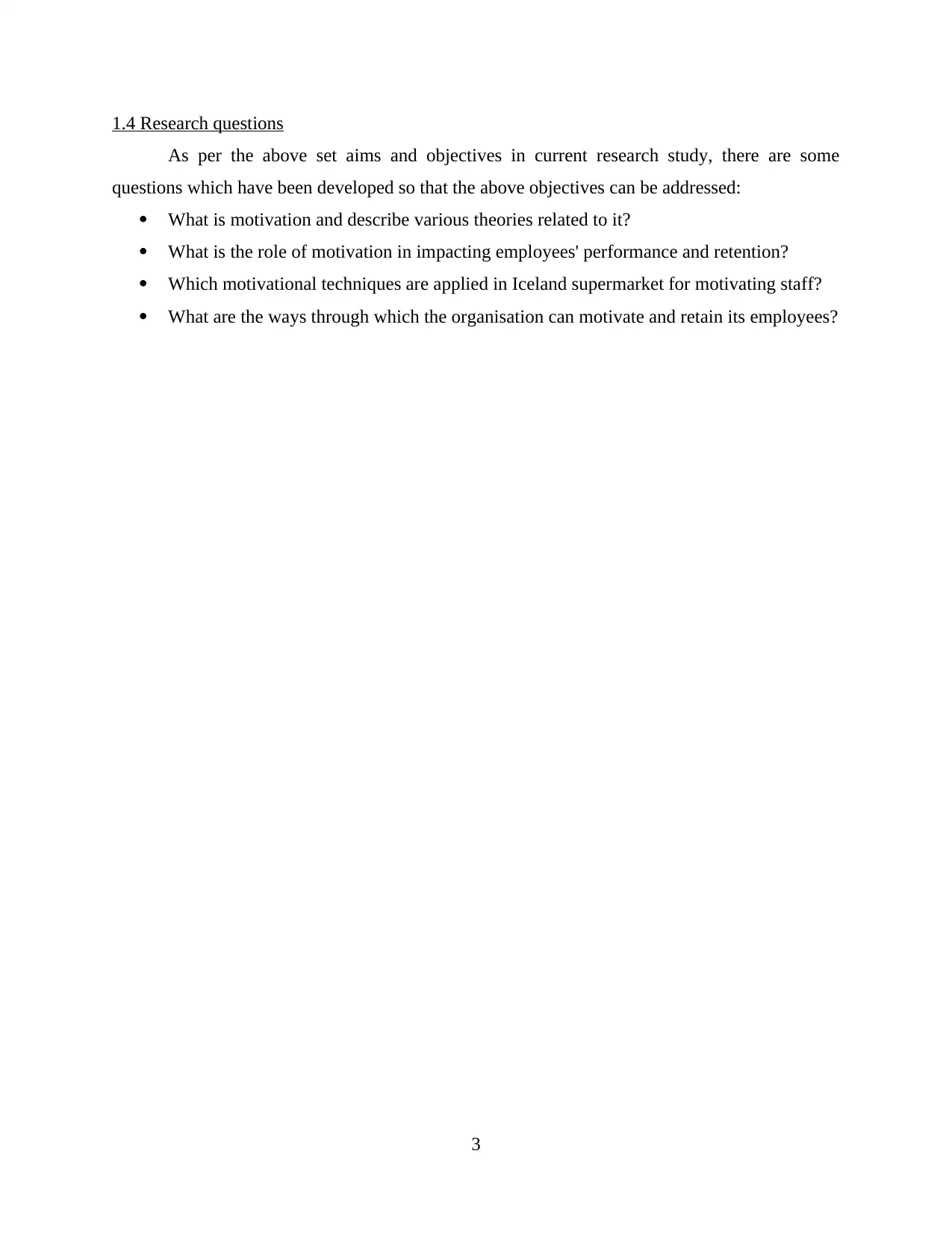
1.4 Research questions
As per the above set aims and objectives in current research study, there are some
questions which have been developed so that the above objectives can be addressed:
What is motivation and describe various theories related to it?
What is the role of motivation in impacting employees' performance and retention?
Which motivational techniques are applied in Iceland supermarket for motivating staff?
What are the ways through which the organisation can motivate and retain its employees?
3
As per the above set aims and objectives in current research study, there are some
questions which have been developed so that the above objectives can be addressed:
What is motivation and describe various theories related to it?
What is the role of motivation in impacting employees' performance and retention?
Which motivational techniques are applied in Iceland supermarket for motivating staff?
What are the ways through which the organisation can motivate and retain its employees?
3
⊘ This is a preview!⊘
Do you want full access?
Subscribe today to unlock all pages.

Trusted by 1+ million students worldwide
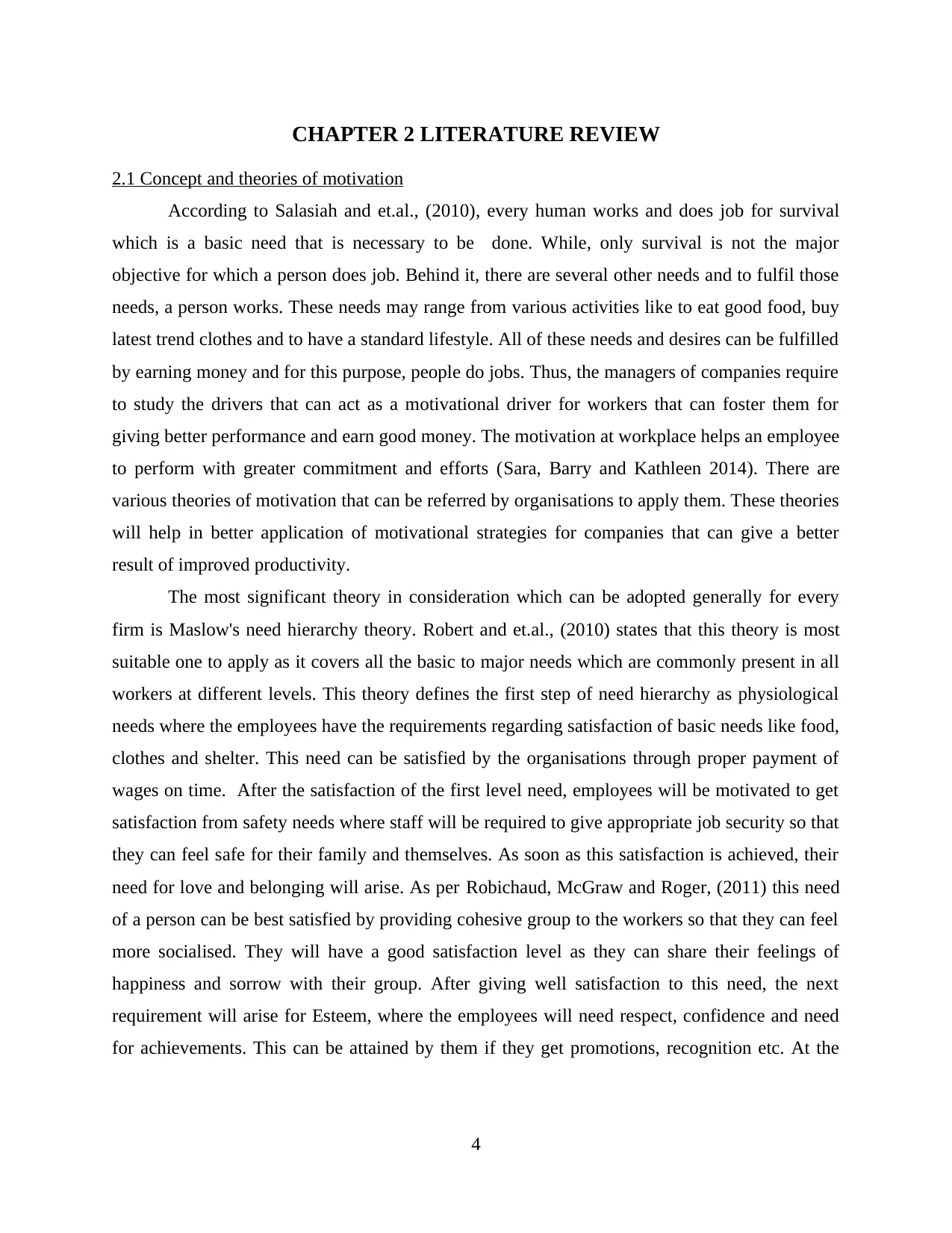
CHAPTER 2 LITERATURE REVIEW
2.1 Concept and theories of motivation
According to Salasiah and et.al., (2010), every human works and does job for survival
which is a basic need that is necessary to be done. While, only survival is not the major
objective for which a person does job. Behind it, there are several other needs and to fulfil those
needs, a person works. These needs may range from various activities like to eat good food, buy
latest trend clothes and to have a standard lifestyle. All of these needs and desires can be fulfilled
by earning money and for this purpose, people do jobs. Thus, the managers of companies require
to study the drivers that can act as a motivational driver for workers that can foster them for
giving better performance and earn good money. The motivation at workplace helps an employee
to perform with greater commitment and efforts (Sara, Barry and Kathleen 2014). There are
various theories of motivation that can be referred by organisations to apply them. These theories
will help in better application of motivational strategies for companies that can give a better
result of improved productivity.
The most significant theory in consideration which can be adopted generally for every
firm is Maslow's need hierarchy theory. Robert and et.al., (2010) states that this theory is most
suitable one to apply as it covers all the basic to major needs which are commonly present in all
workers at different levels. This theory defines the first step of need hierarchy as physiological
needs where the employees have the requirements regarding satisfaction of basic needs like food,
clothes and shelter. This need can be satisfied by the organisations through proper payment of
wages on time. After the satisfaction of the first level need, employees will be motivated to get
satisfaction from safety needs where staff will be required to give appropriate job security so that
they can feel safe for their family and themselves. As soon as this satisfaction is achieved, their
need for love and belonging will arise. As per Robichaud, McGraw and Roger, (2011) this need
of a person can be best satisfied by providing cohesive group to the workers so that they can feel
more socialised. They will have a good satisfaction level as they can share their feelings of
happiness and sorrow with their group. After giving well satisfaction to this need, the next
requirement will arise for Esteem, where the employees will need respect, confidence and need
for achievements. This can be attained by them if they get promotions, recognition etc. At the
4
2.1 Concept and theories of motivation
According to Salasiah and et.al., (2010), every human works and does job for survival
which is a basic need that is necessary to be done. While, only survival is not the major
objective for which a person does job. Behind it, there are several other needs and to fulfil those
needs, a person works. These needs may range from various activities like to eat good food, buy
latest trend clothes and to have a standard lifestyle. All of these needs and desires can be fulfilled
by earning money and for this purpose, people do jobs. Thus, the managers of companies require
to study the drivers that can act as a motivational driver for workers that can foster them for
giving better performance and earn good money. The motivation at workplace helps an employee
to perform with greater commitment and efforts (Sara, Barry and Kathleen 2014). There are
various theories of motivation that can be referred by organisations to apply them. These theories
will help in better application of motivational strategies for companies that can give a better
result of improved productivity.
The most significant theory in consideration which can be adopted generally for every
firm is Maslow's need hierarchy theory. Robert and et.al., (2010) states that this theory is most
suitable one to apply as it covers all the basic to major needs which are commonly present in all
workers at different levels. This theory defines the first step of need hierarchy as physiological
needs where the employees have the requirements regarding satisfaction of basic needs like food,
clothes and shelter. This need can be satisfied by the organisations through proper payment of
wages on time. After the satisfaction of the first level need, employees will be motivated to get
satisfaction from safety needs where staff will be required to give appropriate job security so that
they can feel safe for their family and themselves. As soon as this satisfaction is achieved, their
need for love and belonging will arise. As per Robichaud, McGraw and Roger, (2011) this need
of a person can be best satisfied by providing cohesive group to the workers so that they can feel
more socialised. They will have a good satisfaction level as they can share their feelings of
happiness and sorrow with their group. After giving well satisfaction to this need, the next
requirement will arise for Esteem, where the employees will need respect, confidence and need
for achievements. This can be attained by them if they get promotions, recognition etc. At the
4
Paraphrase This Document
Need a fresh take? Get an instant paraphrase of this document with our AI Paraphraser
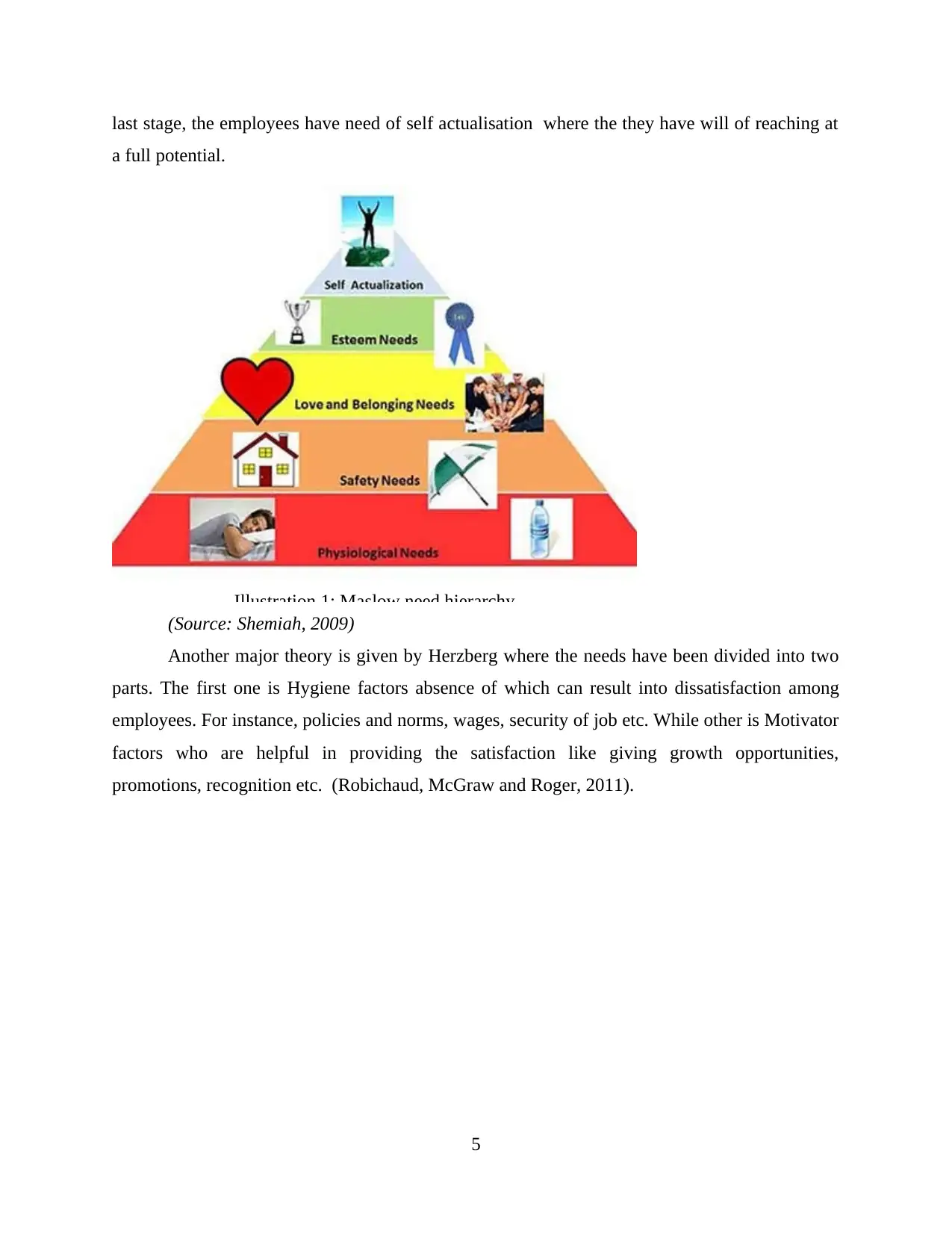
last stage, the employees have need of self actualisation where the they have will of reaching at
a full potential.
Illustration 1: Maslow need hierarchy
(Source: Shemiah, 2009)
Another major theory is given by Herzberg where the needs have been divided into two
parts. The first one is Hygiene factors absence of which can result into dissatisfaction among
employees. For instance, policies and norms, wages, security of job etc. While other is Motivator
factors who are helpful in providing the satisfaction like giving growth opportunities,
promotions, recognition etc. (Robichaud, McGraw and Roger, 2011).
5
a full potential.
Illustration 1: Maslow need hierarchy
(Source: Shemiah, 2009)
Another major theory is given by Herzberg where the needs have been divided into two
parts. The first one is Hygiene factors absence of which can result into dissatisfaction among
employees. For instance, policies and norms, wages, security of job etc. While other is Motivator
factors who are helpful in providing the satisfaction like giving growth opportunities,
promotions, recognition etc. (Robichaud, McGraw and Roger, 2011).
5
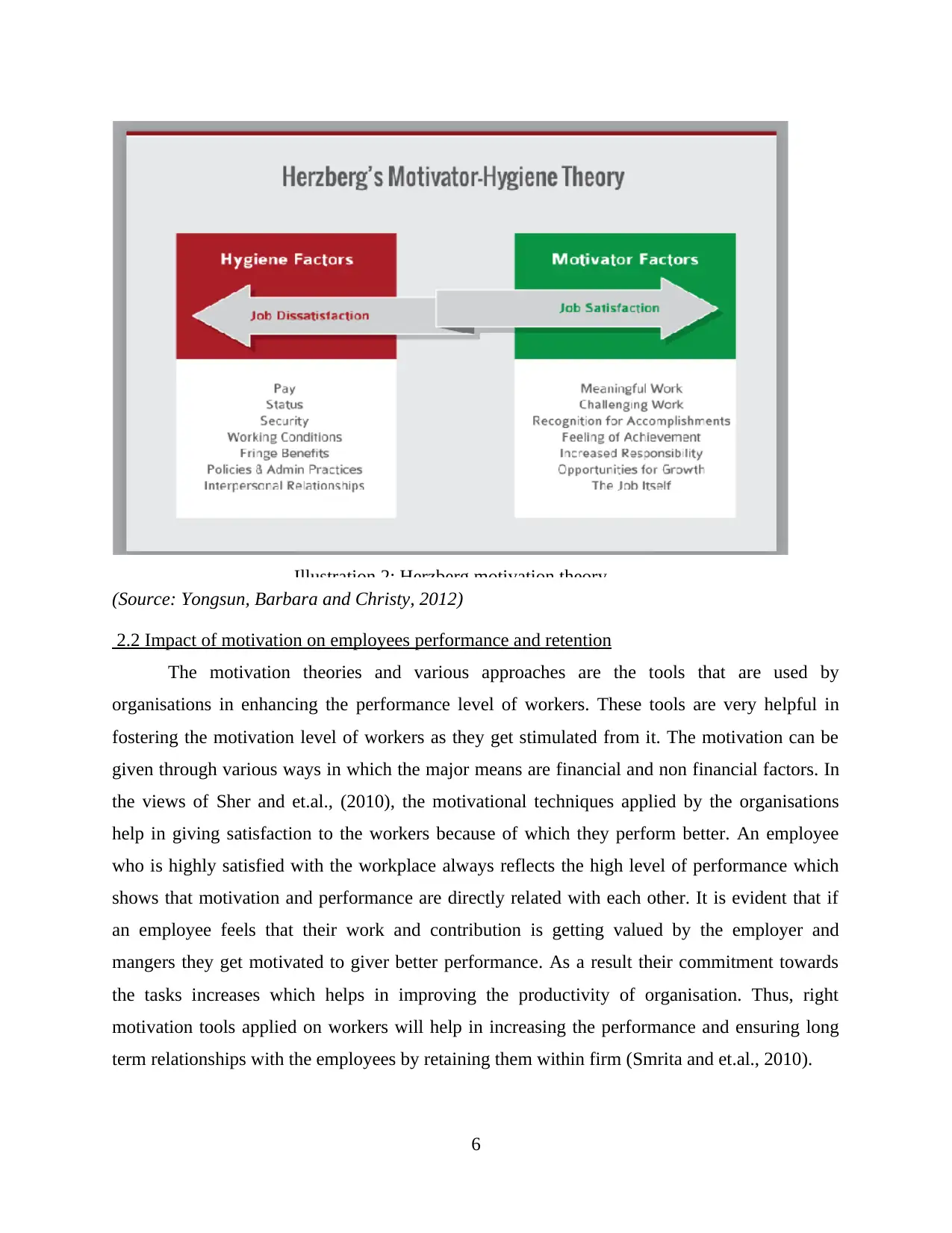
Illustration 2: Herzberg motivation theory
(Source: Yongsun, Barbara and Christy, 2012)
2.2 Impact of motivation on employees performance and retention
The motivation theories and various approaches are the tools that are used by
organisations in enhancing the performance level of workers. These tools are very helpful in
fostering the motivation level of workers as they get stimulated from it. The motivation can be
given through various ways in which the major means are financial and non financial factors. In
the views of Sher and et.al., (2010), the motivational techniques applied by the organisations
help in giving satisfaction to the workers because of which they perform better. An employee
who is highly satisfied with the workplace always reflects the high level of performance which
shows that motivation and performance are directly related with each other. It is evident that if
an employee feels that their work and contribution is getting valued by the employer and
mangers they get motivated to giver better performance. As a result their commitment towards
the tasks increases which helps in improving the productivity of organisation. Thus, right
motivation tools applied on workers will help in increasing the performance and ensuring long
term relationships with the employees by retaining them within firm (Smrita and et.al., 2010).
6
(Source: Yongsun, Barbara and Christy, 2012)
2.2 Impact of motivation on employees performance and retention
The motivation theories and various approaches are the tools that are used by
organisations in enhancing the performance level of workers. These tools are very helpful in
fostering the motivation level of workers as they get stimulated from it. The motivation can be
given through various ways in which the major means are financial and non financial factors. In
the views of Sher and et.al., (2010), the motivational techniques applied by the organisations
help in giving satisfaction to the workers because of which they perform better. An employee
who is highly satisfied with the workplace always reflects the high level of performance which
shows that motivation and performance are directly related with each other. It is evident that if
an employee feels that their work and contribution is getting valued by the employer and
mangers they get motivated to giver better performance. As a result their commitment towards
the tasks increases which helps in improving the productivity of organisation. Thus, right
motivation tools applied on workers will help in increasing the performance and ensuring long
term relationships with the employees by retaining them within firm (Smrita and et.al., 2010).
6
⊘ This is a preview!⊘
Do you want full access?
Subscribe today to unlock all pages.

Trusted by 1+ million students worldwide
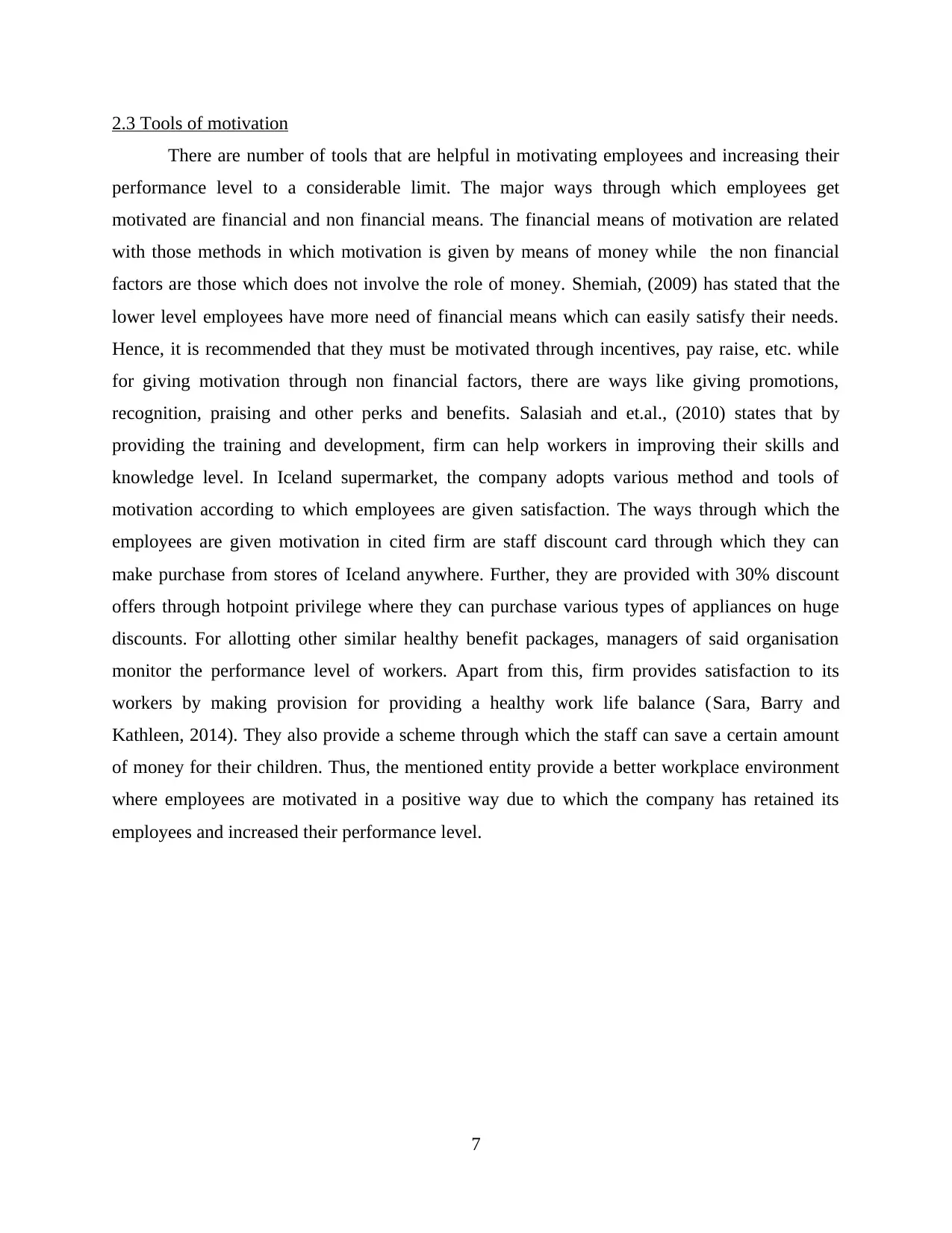
2.3 Tools of motivation
There are number of tools that are helpful in motivating employees and increasing their
performance level to a considerable limit. The major ways through which employees get
motivated are financial and non financial means. The financial means of motivation are related
with those methods in which motivation is given by means of money while the non financial
factors are those which does not involve the role of money. Shemiah, (2009) has stated that the
lower level employees have more need of financial means which can easily satisfy their needs.
Hence, it is recommended that they must be motivated through incentives, pay raise, etc. while
for giving motivation through non financial factors, there are ways like giving promotions,
recognition, praising and other perks and benefits. Salasiah and et.al., (2010) states that by
providing the training and development, firm can help workers in improving their skills and
knowledge level. In Iceland supermarket, the company adopts various method and tools of
motivation according to which employees are given satisfaction. The ways through which the
employees are given motivation in cited firm are staff discount card through which they can
make purchase from stores of Iceland anywhere. Further, they are provided with 30% discount
offers through hotpoint privilege where they can purchase various types of appliances on huge
discounts. For allotting other similar healthy benefit packages, managers of said organisation
monitor the performance level of workers. Apart from this, firm provides satisfaction to its
workers by making provision for providing a healthy work life balance (Sara, Barry and
Kathleen, 2014). They also provide a scheme through which the staff can save a certain amount
of money for their children. Thus, the mentioned entity provide a better workplace environment
where employees are motivated in a positive way due to which the company has retained its
employees and increased their performance level.
7
There are number of tools that are helpful in motivating employees and increasing their
performance level to a considerable limit. The major ways through which employees get
motivated are financial and non financial means. The financial means of motivation are related
with those methods in which motivation is given by means of money while the non financial
factors are those which does not involve the role of money. Shemiah, (2009) has stated that the
lower level employees have more need of financial means which can easily satisfy their needs.
Hence, it is recommended that they must be motivated through incentives, pay raise, etc. while
for giving motivation through non financial factors, there are ways like giving promotions,
recognition, praising and other perks and benefits. Salasiah and et.al., (2010) states that by
providing the training and development, firm can help workers in improving their skills and
knowledge level. In Iceland supermarket, the company adopts various method and tools of
motivation according to which employees are given satisfaction. The ways through which the
employees are given motivation in cited firm are staff discount card through which they can
make purchase from stores of Iceland anywhere. Further, they are provided with 30% discount
offers through hotpoint privilege where they can purchase various types of appliances on huge
discounts. For allotting other similar healthy benefit packages, managers of said organisation
monitor the performance level of workers. Apart from this, firm provides satisfaction to its
workers by making provision for providing a healthy work life balance (Sara, Barry and
Kathleen, 2014). They also provide a scheme through which the staff can save a certain amount
of money for their children. Thus, the mentioned entity provide a better workplace environment
where employees are motivated in a positive way due to which the company has retained its
employees and increased their performance level.
7
Paraphrase This Document
Need a fresh take? Get an instant paraphrase of this document with our AI Paraphraser
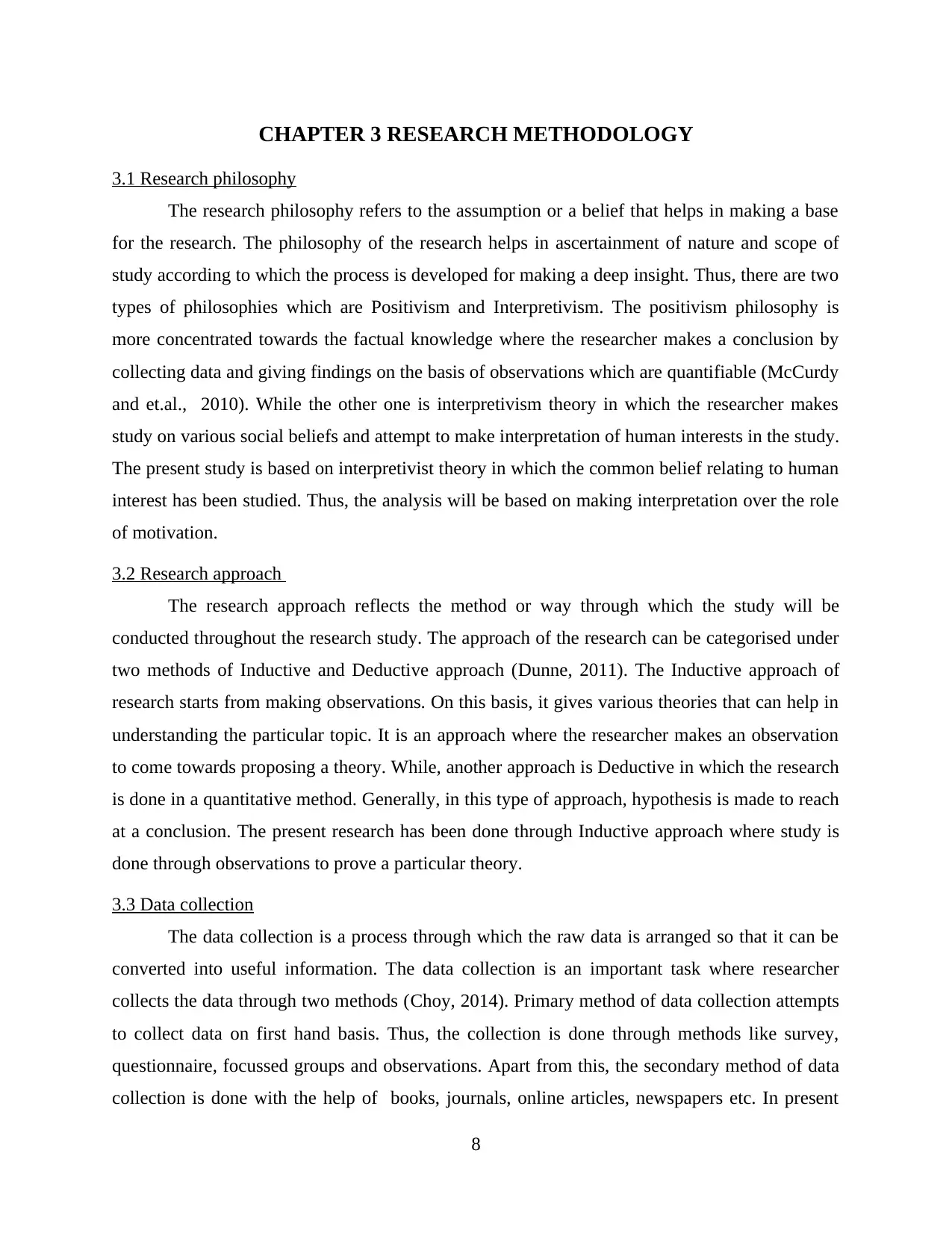
CHAPTER 3 RESEARCH METHODOLOGY
3.1 Research philosophy
The research philosophy refers to the assumption or a belief that helps in making a base
for the research. The philosophy of the research helps in ascertainment of nature and scope of
study according to which the process is developed for making a deep insight. Thus, there are two
types of philosophies which are Positivism and Interpretivism. The positivism philosophy is
more concentrated towards the factual knowledge where the researcher makes a conclusion by
collecting data and giving findings on the basis of observations which are quantifiable (McCurdy
and et.al., 2010). While the other one is interpretivism theory in which the researcher makes
study on various social beliefs and attempt to make interpretation of human interests in the study.
The present study is based on interpretivist theory in which the common belief relating to human
interest has been studied. Thus, the analysis will be based on making interpretation over the role
of motivation.
3.2 Research approach
The research approach reflects the method or way through which the study will be
conducted throughout the research study. The approach of the research can be categorised under
two methods of Inductive and Deductive approach (Dunne, 2011). The Inductive approach of
research starts from making observations. On this basis, it gives various theories that can help in
understanding the particular topic. It is an approach where the researcher makes an observation
to come towards proposing a theory. While, another approach is Deductive in which the research
is done in a quantitative method. Generally, in this type of approach, hypothesis is made to reach
at a conclusion. The present research has been done through Inductive approach where study is
done through observations to prove a particular theory.
3.3 Data collection
The data collection is a process through which the raw data is arranged so that it can be
converted into useful information. The data collection is an important task where researcher
collects the data through two methods (Choy, 2014). Primary method of data collection attempts
to collect data on first hand basis. Thus, the collection is done through methods like survey,
questionnaire, focussed groups and observations. Apart from this, the secondary method of data
collection is done with the help of books, journals, online articles, newspapers etc. In present
8
3.1 Research philosophy
The research philosophy refers to the assumption or a belief that helps in making a base
for the research. The philosophy of the research helps in ascertainment of nature and scope of
study according to which the process is developed for making a deep insight. Thus, there are two
types of philosophies which are Positivism and Interpretivism. The positivism philosophy is
more concentrated towards the factual knowledge where the researcher makes a conclusion by
collecting data and giving findings on the basis of observations which are quantifiable (McCurdy
and et.al., 2010). While the other one is interpretivism theory in which the researcher makes
study on various social beliefs and attempt to make interpretation of human interests in the study.
The present study is based on interpretivist theory in which the common belief relating to human
interest has been studied. Thus, the analysis will be based on making interpretation over the role
of motivation.
3.2 Research approach
The research approach reflects the method or way through which the study will be
conducted throughout the research study. The approach of the research can be categorised under
two methods of Inductive and Deductive approach (Dunne, 2011). The Inductive approach of
research starts from making observations. On this basis, it gives various theories that can help in
understanding the particular topic. It is an approach where the researcher makes an observation
to come towards proposing a theory. While, another approach is Deductive in which the research
is done in a quantitative method. Generally, in this type of approach, hypothesis is made to reach
at a conclusion. The present research has been done through Inductive approach where study is
done through observations to prove a particular theory.
3.3 Data collection
The data collection is a process through which the raw data is arranged so that it can be
converted into useful information. The data collection is an important task where researcher
collects the data through two methods (Choy, 2014). Primary method of data collection attempts
to collect data on first hand basis. Thus, the collection is done through methods like survey,
questionnaire, focussed groups and observations. Apart from this, the secondary method of data
collection is done with the help of books, journals, online articles, newspapers etc. In present
8
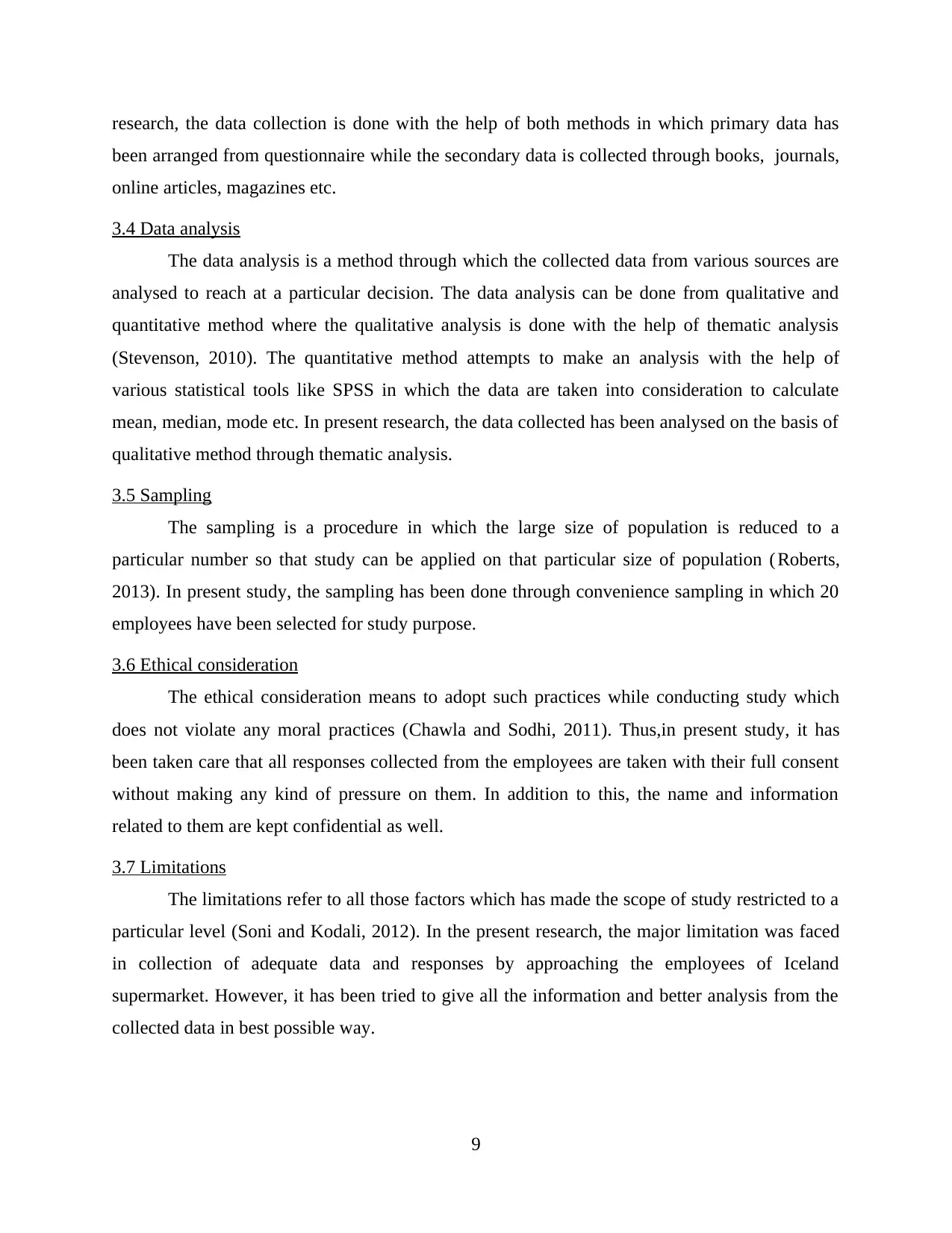
research, the data collection is done with the help of both methods in which primary data has
been arranged from questionnaire while the secondary data is collected through books, journals,
online articles, magazines etc.
3.4 Data analysis
The data analysis is a method through which the collected data from various sources are
analysed to reach at a particular decision. The data analysis can be done from qualitative and
quantitative method where the qualitative analysis is done with the help of thematic analysis
(Stevenson, 2010). The quantitative method attempts to make an analysis with the help of
various statistical tools like SPSS in which the data are taken into consideration to calculate
mean, median, mode etc. In present research, the data collected has been analysed on the basis of
qualitative method through thematic analysis.
3.5 Sampling
The sampling is a procedure in which the large size of population is reduced to a
particular number so that study can be applied on that particular size of population (Roberts,
2013). In present study, the sampling has been done through convenience sampling in which 20
employees have been selected for study purpose.
3.6 Ethical consideration
The ethical consideration means to adopt such practices while conducting study which
does not violate any moral practices (Chawla and Sodhi, 2011). Thus,in present study, it has
been taken care that all responses collected from the employees are taken with their full consent
without making any kind of pressure on them. In addition to this, the name and information
related to them are kept confidential as well.
3.7 Limitations
The limitations refer to all those factors which has made the scope of study restricted to a
particular level (Soni and Kodali, 2012). In the present research, the major limitation was faced
in collection of adequate data and responses by approaching the employees of Iceland
supermarket. However, it has been tried to give all the information and better analysis from the
collected data in best possible way.
9
been arranged from questionnaire while the secondary data is collected through books, journals,
online articles, magazines etc.
3.4 Data analysis
The data analysis is a method through which the collected data from various sources are
analysed to reach at a particular decision. The data analysis can be done from qualitative and
quantitative method where the qualitative analysis is done with the help of thematic analysis
(Stevenson, 2010). The quantitative method attempts to make an analysis with the help of
various statistical tools like SPSS in which the data are taken into consideration to calculate
mean, median, mode etc. In present research, the data collected has been analysed on the basis of
qualitative method through thematic analysis.
3.5 Sampling
The sampling is a procedure in which the large size of population is reduced to a
particular number so that study can be applied on that particular size of population (Roberts,
2013). In present study, the sampling has been done through convenience sampling in which 20
employees have been selected for study purpose.
3.6 Ethical consideration
The ethical consideration means to adopt such practices while conducting study which
does not violate any moral practices (Chawla and Sodhi, 2011). Thus,in present study, it has
been taken care that all responses collected from the employees are taken with their full consent
without making any kind of pressure on them. In addition to this, the name and information
related to them are kept confidential as well.
3.7 Limitations
The limitations refer to all those factors which has made the scope of study restricted to a
particular level (Soni and Kodali, 2012). In the present research, the major limitation was faced
in collection of adequate data and responses by approaching the employees of Iceland
supermarket. However, it has been tried to give all the information and better analysis from the
collected data in best possible way.
9
⊘ This is a preview!⊘
Do you want full access?
Subscribe today to unlock all pages.

Trusted by 1+ million students worldwide
1 out of 23
Related Documents
Your All-in-One AI-Powered Toolkit for Academic Success.
+13062052269
info@desklib.com
Available 24*7 on WhatsApp / Email
![[object Object]](/_next/static/media/star-bottom.7253800d.svg)
Unlock your academic potential
Copyright © 2020–2025 A2Z Services. All Rights Reserved. Developed and managed by ZUCOL.





